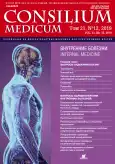FUNCTIONAL STATE OF THE CARDIOVASCULAR SYSTEM IN PATIENTS WITH ACUTE CORONARY SYNDROME AND TYPES OF BEHAVIORAL ACTIVITY A, AB, B
- Authors: Martynov A.I.1, Akatova E.V.1, Pervichko E.I.2, Nikolin O.P.1, Urlaeva I.V.1,3
-
Affiliations:
- Yevdokimov Moscow State University of Medicine and Dentistry
- Lomonosov Moscow State University
- City Clinical Hospital №40
- Issue: Vol 21, No 12 (2019)
- Pages: 89-94
- Section: Articles
- URL: https://journals.rcsi.science/2075-1753/article/view/95238
- DOI: https://doi.org/10.26442/20751753.2019.12.190726
- ID: 95238
Cite item
Full Text
Abstract
Full Text
##article.viewOnOriginalSite##About the authors
Anatoly I. Martynov
Yevdokimov Moscow State University of Medicine and Dentistryакад. РАН, д-р мед. наук, проф. проф. каф. госпитальной терапии
Evgeniya V. Akatova
Yevdokimov Moscow State University of Medicine and Dentistryд-р мед. наук, проф. каф. госпитальной терапии
Elena I. Pervichko
Lomonosov Moscow State Universityд-р психол. наук, доц. каф. нейро- и патопсихологии фак-та психологии
Olesya P. Nikolin
Yevdokimov Moscow State University of Medicine and Dentistryдоц. каф. госпитальной терапии
Inna V. Urlaeva
Yevdokimov Moscow State University of Medicine and Dentistry; City Clinical Hospital №40
Email: md.urlaeva@yandex.ru
ассистент каф. госпитальной терапии
References
- Всемирная организация здравоохранения. http://www.who.int/mediacentre/factsheets/fs310/ru @@World Health Organization. http://www.who.int/mediacentre/factsheets/fs310/ru (in Russian).
- Кэмм А.Д., Люшер Т.Ф., Серриус П.В. Болезни сердца и сосудов. Руководство Европейского общества кардиологов. Пер. с англ. под ред. Е.В.Шляхто. М., 2011. @@Kamm A.D., Lusher T.F., Serrius P.V. Diseases of the heart and blood vessels. Guidelines of the European Society of Cardiology. Translation from English under the editorship of E.V. Shlyakhto. Moscow, 2011 (in Russian).
- Friedman M, Breall WS, Goodwin ML. Effect of type A behavioral counseling on frequency of episodes of silent myocar-dial ischemia in coronary patients. Am Heart J 1996; 132 (5): 933-7.
- Glass DC. Type A behavior: Mechanisms linking behavioral and pathophysiologic processes. J.Si-egrist, M.J.Halhuber (Eds.). Myocardial infarction and psychosocial risks. Springer-Verlag Berlin Heidelberg, 1981.
- Eaker ED, Sullivan LM, Kelly-Hayes M е ак Anger and hostility predict the development of atrial fibrillation in men in the Framingham Offspring Study. Circulation 2014; 109 (10): 1267-71.
- Emdad R, Sondergaard HP. Impaired memory and general intelligence related to severity and duration of patients' disease in Type A posttraumatic stress disorder. Behav Med 2015; 31 (2): 73-84.
- Kanda A, Kawaguchi T A study of school children with type A behavior pattern association of "competitiveness" and "impatience-aggression" with lifestyle-related factors. Nippon Koshu Eisei Zasshi 2012; 49 (3): 167-77.
- Liu H, Saijo Y, Zhang X. Impact of type A behavior on brachial-ankle pulse wave velocity in Japanese. Tohoku J Exp Med 2016; 209 (1): 15-21.
- Yoshimasu K, Washio M, Toku-naga S. Relation between type A beha-vior pattern and the extent of coronary atherosclerosis in Japanese women. Int J Behav Med 2014; 9 (2): 77-93.
- Friedman M. Type A behavior pattern: some of its pathophysiological components. Bull NY Acad Med 1977; 53: 593-604.
- Sharma A. Hypertension: psychological fallout of type A, stress, anxiety and anger. AASS 2012; 3 (4): 751-8.
- Irvine J, Garner DM, Craig HM, Logan AG. Prevalence of Type A behavior in untreated hypertensive individuals. Hypertension 1991; 18: 72-8.
- Sirri L, Fava GA, Guidi J et al. Type A behaviour: A reappraisal of its characteristics in cardiovascular disease. Intern J Clin Practice 2012; 66 (9): 854-61. doi: 10.1111/j.1742-1241.2012.02993
- Smigelskas K, Zemaitiene N, Julkunen J, Kauhanen J. Type A Behavior Pattern is not a Predictor of Premature Mortality. Int J Behav Med 2015; 22. Issue 2: 161-9. http://dx.doi.org/10.1007/s12529-014-9435-1
- Mann SJ. Psychosomatic Research in Hypertension: The Lack of Impact of Decades of Research and New Directions to Consider. J Clin Hypertens 2012; 14 (10): 657-64.
- Taylor GJ. The psychosomatic medicine and contemporary psychoanalysis. 3rd ed. Madison, Connecticut: Int Univ Press, 1987.
- Wise TN. Psychosomatics: Past, Present and Future. Psychother Psychosom 2014; 83 (2): 65-9.
- Recommendations for cardiac chamber quantification by echocardiography in adults: an update from the American Society of Echocardiography and the European Association of Cardiovascular Imaging. J Am Soc Echocardiogr 2015; 16 (3): 233-70.
Supplementary files






